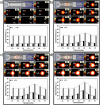Spillover can limit accurate signal quantification in MPI
- PMID: 40604257
- PMCID: PMC12118701
- DOI: 10.1038/s44303-025-00084-0
Spillover can limit accurate signal quantification in MPI
Abstract
Accurate quantification of the magnetic particle imaging (MPI) signal in vivo remains a significant technical challenge. We assessed the "spillover effect", defined as leakage of signal from adjacent areas within a region of interest, within a field of view containing multiple hot spots, a scenario frequently encountered in vivo after systemic administration of a magnetic tracer. Using custom-designed phantom and in vivo mouse studies we determined the impact of fiducial positioning, iron content, and the iron concentration ratios within those hot spots, as well as the suitability of four different MPI scan modes for accurate signal quantification. Adjustment of the specific "target-to-fiducial distance (TFD)" and "target-to-fiducial Fe concentration ratios (TFCR)" significantly reduced the spillover effect. It's implementation to mitigate spillover effects will increase the accuracy of MPI for in vivo magnetic tracer quantification.
© 2025. The Author(s).
Conflict of interest statement
Competing interests: J.W.M.B. is a paid scientific advisory board member and shareholder of SuperBranche. This arrangement has been reviewed and approved by Johns Hopkins University in accordance with its conflict-of-interest policies. The others have nothing to disclose.
Figures





Similar articles
-
Magnetic particle imaging resolution needed for magnetic hyperthermia treatment planning: a sensitivity analysis.Front Therm Eng. 2025;5:1520951. doi: 10.3389/fther.2025.1520951. Epub 2025 Feb 16. Front Therm Eng. 2025. PMID: 40303353
-
Magnetic particle imaging enables nonradioactive quantitative sentinel lymph node identification: feasibility proof in murine models.Radiol Adv. 2024 Oct 25;1(3):umae024. doi: 10.1093/radadv/umae024. eCollection 2024 Sep. Radiol Adv. 2024. PMID: 39574515 Free PMC article.
-
Artificial Intelligence Analysis of Magnetic Particle Imaging for Islet Transplantation in a Mouse Model.Mol Imaging Biol. 2021 Feb;23(1):18-29. doi: 10.1007/s11307-020-01533-5. Epub 2020 Aug 24. Mol Imaging Biol. 2021. PMID: 32833112 Free PMC article.
-
Methods for blood loss estimation after vaginal birth.Cochrane Database Syst Rev. 2018 Sep 13;9(9):CD010980. doi: 10.1002/14651858.CD010980.pub2. Cochrane Database Syst Rev. 2018. PMID: 30211952 Free PMC article.
-
Healthcare outcomes assessed with observational study designs compared with those assessed in randomized trials.Cochrane Database Syst Rev. 2014 Apr 29;2014(4):MR000034. doi: 10.1002/14651858.MR000034.pub2. Cochrane Database Syst Rev. 2014. Update in: Cochrane Database Syst Rev. 2024 Jan 4;1:MR000034. doi: 10.1002/14651858.MR000034.pub3. PMID: 24782322 Free PMC article. Updated.
References
Grants and funding
LinkOut - more resources
Full Text Sources
